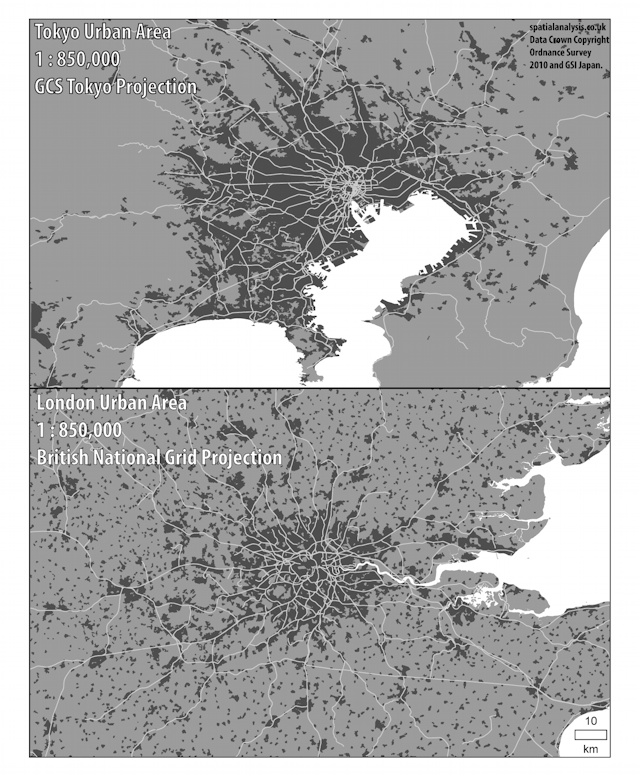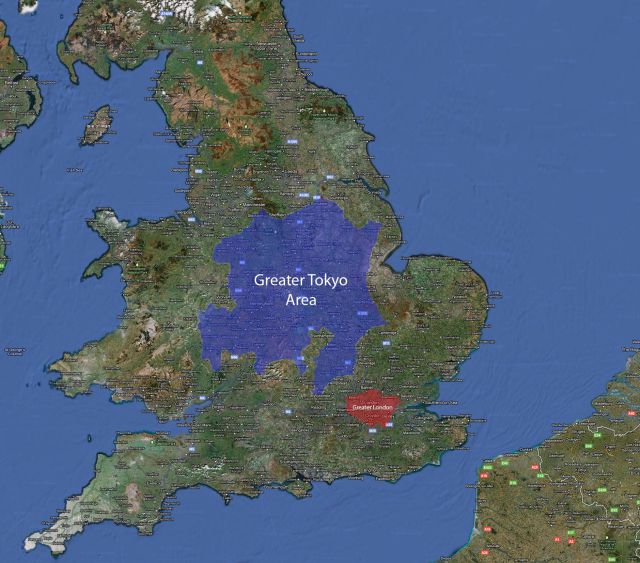I was intrigued by this tweet that appeared in my Twitter client this morning:
It’s one of those tweets that makes you go “That doesn’t sound right?”
Is Tokyo really a third of the size of England? It generally takes just under four hours by highish-speed train from London to the edge of England (Berwick) and a similar amount of time to get down to Cornwall. Even Wales is a good couple of hours away. I know they have ultra-fast trains in Japan but can Tokyo really be that big?
The link offers up the following map as proof, which appears to be based on Google Earth (very likely Copyright Google and its aerial imagery partners):
Some of the comments on the source article mention the key point that the Toyko metropolitan area, an administrative area, contains a large amount of rural land. The same is somewhat true of London – parts of the south-eastern fringe of the Greater London Authority (GLA) area are very definitely rural, and conversely built-up areas (Loughton) are outside of the GLA but part of the London continuous urban area and very much feel part of London – e.g. it’s on the tube network and in Zone 6.
Another example of administrative areas not coinciding with urban areas is that the City of Edinburgh council area extends well away from the city – but only to the west (i.e. to the Forth Bridge). In all other directions, the boundary is not far from the city bypass which is itself not far from the urban area, or there’s water in the way.
So a better comparison would be to visually compare the built-up areas of the two cities, first of all making sure that the scales are exactly the same and that the projections are appropriate for each city – I’m not saying this is not the case for the Google Earth example, although you do have to be careful with how Google Earth displays scales for, and projects, very large areas, as they are not always 100% rigorous.
I asked James of Spatial Analysis to have a quick look, as he had the data to hand, and he’s produced the rather lovely map which is at the top of this article. Thanks James! The dark grey areas are built-up areas and railways and the land and sea are also shown for context. A rough visual comparison of the map shows the urban area of Tokyo is maybe 3 times the size of London. This kind of equates to the population difference (8.5 million vs 31 million, using very rough numbers) and shows that Tokyo would fit quite snugly into Kent, rather than taking up much of southern England as the original statement implied – its own map, while exaggerating the urban area, also doesn’t quite cover a third of the nation.
(As an aside – it’s tricky to define exactly what a metropolitan area is – Wikipedia’s article for instance has very different numbers.)
So Tokyo is big – yes – but not nation-eating gigantic. I could probably just about cope with it.



4 replies on “The Relative Urban Footprint of Tokyo and London”
Thank you very much for this lovely article! I have one question please: what do you exactly mean by built-up area?
Does it mean only areas on which there are buildings and constructions? Thank you!
It’s the area where there is a continuous urban extent – so yes buildings/construction sites, but not including those in isolated towns/villages which are surrounded by greenery.
Again thanks for taking the time to do this. Nothing like a good de-bunking!!
Great to get an answer so easily, to a question that popped into my head whilst pawing over a (rather nice) map of Japan, before my imminent trip to Tokyo and its environs.
Thanks for saving me the trawl through vaguely related google results that I was expecting to have to go through to satisfy my curiosity.
Nice one!
L
Thanks for the effort that you took to delve deeper into the ‘reality’ behind the diagram. Another reminder of the nuanced nature of a lot of human geography, particularly defining the end of an urban area like London. Plenty of scope to use this now as the basis for a student investigation to take it further….
Loving your work !
GeoBlogs